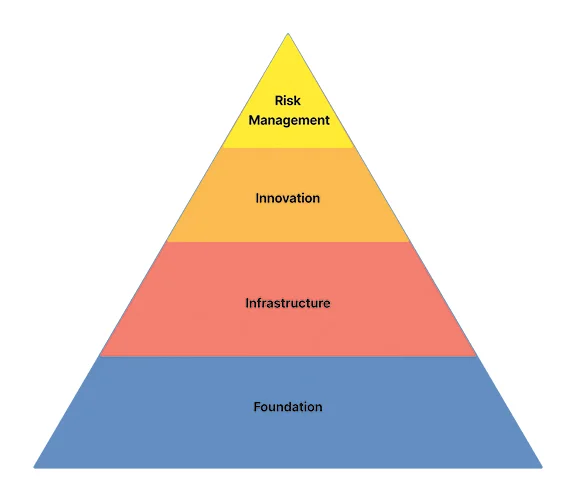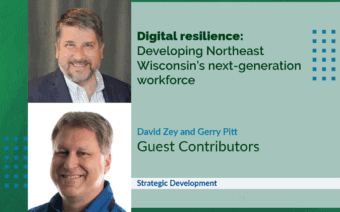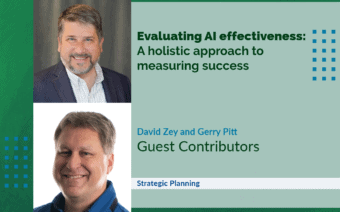
November 13, 2023
As mentioned in my previous columns, in today’s rapidly evolving business landscape, the IT Management and Growth Pyramid can be used as a guide for manageable and effective technology planning.
In this final piece, I will zero in on the pyramid’s growth layers: Innovation and Risk Management – layers crucial for achieving a bimodal IT strategy that integrates innovative growth as a long-term technology asset within your company.

Innovation is baseball
Innovation in technology planning can be likened to a game of baseball, where both risk and reward are integral parts of the game.
Just as swinging for a home run comes with the risk of a strikeout, pursuing innovation involves balancing the potential for significant achievements against the possibility of setbacks.
This process should be iterative, focusing on a cycle of risk mitigation, opportunity validation and securing swift, incremental progress.
First base: Awareness – The first step is understanding the current trends, technologies and innovations within your industry. This awareness comes from networking, reading up on the latest developments, engaging with the voice of the customer, attending industry events and having a deep understanding of your product and its market position.Second base: Exploration – Here, you identify high-value initiatives within your organization that warrant exploration. It’s crucial to define the objectives, understand the associated risks and evaluate the potential return on investment and market opportunities. Forming the right mix of business and technology people for brainstorming and ideation is key.Third base: Experimentation – Break down a chosen high-value initiative into manageable steps. This stage is about identifying and reducing risks, discovering potential showstoppers and validating the initiative’s value at key milestones. The aim is to ascertain the project’s feasibility and relative worth to the company before full-scale implementation.Home plate: Productionalization – This involves implementing necessary risk remediation measures before introducing any changes to the organization. This is fortifying the solution to withstand the demands of a production environment and managing the operational transition. Effective communication about these organizational changes and their rollout is crucial for seamless integration and success.
Navigating the bimodal IT lifecycle
In a bimodal IT organization, innovation and operations serve as two distinct yet interconnected realms.
Operations – the foundation of the IT organization – is driven by urgency, efficiency and strict process controls.
Innovation is driven by agility, creativity and risk-taking.
The stark differences in their work cycles present unique challenges in melding these two modes in one organization.
Here are some general guidelines that can be translated to organizations of different sizes.
Maintaining clear distinctions in responsibilities
This is crucial.
Team members should be clearly assigned to either operations or innovation, with distinct responsibilities.
For those juggling both, structuring their schedule to allocate specific uninterrupted time blocks for innovation can enhance focus and output.
If operational tasks predominantly occupy a team member’s time, consider expanding the team or outsourcing to ensure innovative initiatives receive the attention they deserve.
Effective communication, interface layers
These also play a pivotal role.
The operational-engineering relationship benefits from having an engineering liaison role to facilitate translating innovative solutions into production applications.
Engineers, including data scientists and hardware/software engineers, focus on early-stage innovation (second and third bases).
The liaison then takes these advancements through to integration and refinement, aligning them with the company’s operational standards and compliance requirements.
This collaborative approach can help ensure the innovations are not only technically sound but also operationally compliant, a principle that is effective across teams of all sizes.
Business-technology alignment involves appointing a (product) manager who is well-versed in both domains, understanding the business goals, KPIs (key performance indicators) and growth metrics and is adept at directing initiatives from inception (first base) through to completion (home).
Their role is to help ensure business strategies are effectively translated into technological innovations.
Implementing modular technology frameworks can help significantly smooth the transition from innovation to operational systems.
Establishing common, agreed-upon systems of process that allow for the modularization and repeatable deployment of innovations can help foster agility within set standards.
This can lead to an efficient, collaborative workflow between the innovation and operations teams, crucial for a dynamic and productive bimodal IT organization.
A case study: Automation game plan
Plant Manager Greg gathered his operations developer, Mike, and shift leads Cheryl and Eric to discuss the transformative power of robotic process automation (RPA) from industry peers.
Greg, who always values the customer and the team’s input, posed a question: “How can we harness this in our plant and to the benefit of our customers?”
At first base, they dove into understanding RPA’s potential, with Mike sharing articles about its successes in their industry – even networking with counterparts at another local company plant benefiting from process automation.
By second base, they pinpointed production scheduling as the prime candidate for RPA.
Mike’s research led them to a reputable RPA vendor, equipped to address their specific needs.
Third base was about action.
They aimed to revamp scheduling, but understood risks loomed.
How would they interface the RPA with their other software systems?
How would they ensure changes got appropriate approval before releasing the final schedule? The prize was enticing – shaving a full day off weekly planning and swiftly adjusting scheduling for custom orders.
After some initial tests, the process and technology seemed to deliver on that promise.
Home plate was the final stretch.
Mike set up stringent RPA guidelines, ensuring every action was auditable.
Contingency plans were devised for potential RPA downtimes.
Cheryl and Eric rallied their teams, ensuring they understood the value, requirements and how to communicate feedback about the new system.
Through teamwork and incremental progress, the plant was set for a more efficient and profitable future.
Another case study: Revolutionizing buyer trust
Ryan, a product and marketing manager, alongside Amy, a customer success representative, and developers Justin and Stanislav, faced a challenging mission – increase buyer conversion in their self-serve legal service marketplace, enhancing buyer trust and legal service provider engagement.
Beginning at first base, the team delved into improving trust between service buyers and providers.
They explored successful strategies from similar SaaS companies, aiming to boost provider engagement and buyer conversion.
Advancing to second base, the team identified the need for a service provider review and rating feature – which would not only enhance the platform’s reputation but also drive user conversion and provider engagement.
Balancing technology integration, costs and ROI became crucial.
Third base involved crafting a proof of concept (POC) using a third-party software library to ensure the new feature’s compatibility with their tech stack.
Amy’s involvement was pivotal in updating user flows and gathering feature feedback, shaping the feature’s development with Ryan.
The journey was headed for home plate, where the team completed the contracting process with a company that licensed the third-party rating and review library.
They polished and launched the rating and review feature, incorporating it into their existing A/B testing and continuous deployment processes.
User interactions were keenly observed through screen recording technology, and the feature was actively promoted.
The team closely monitored its impact on buyer conversion rates, engaging with service providers to maximize engagement.
This energetic endeavor underscored their commitment to incrementally evolving the legal service marketplace, fostering growth and customer trust.
 Badger State tourism reaches new heights in 2023
Badger State tourism reaches new heights in 2023 ‘It’s about being a champion, a convener and a catalyst’
‘It’s about being a champion, a convener and a catalyst’








